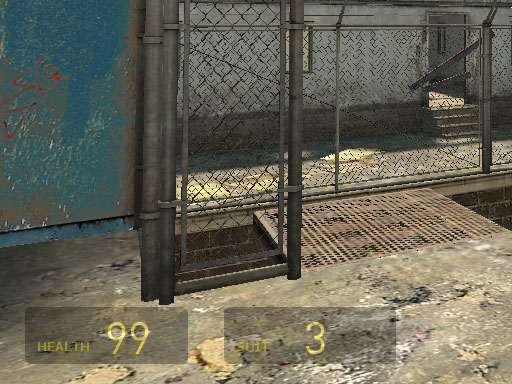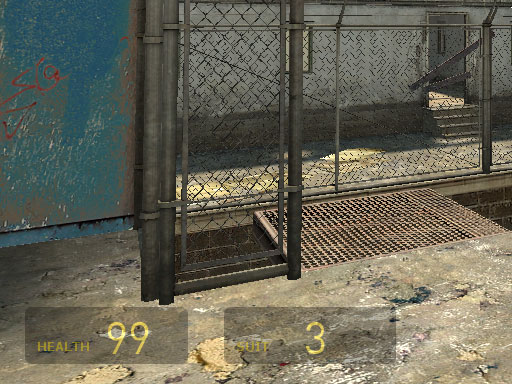Half Life 2 GPU Roundup Part 1 - DirectX 9 Shootout
by Anand Lal Shimpi on November 17, 2004 11:22 AM EST- Posted in
- GPUs
Turning on Anisotropic Filtering
For the most part Half Life 2 doesn’t absolutely beg for anisotropic filtering to be enabled, but there are definitely a few situations where image quality could be improved by turning it on.
Looking at the peach colored metal platform towards the right of the images before you can see some of the benefits of anisotropic filtering in Half Life 2:

Aniso Disabled

8X Aniso Enabled - ATI

8X Aniso Enabled - NVIDIA
So there's definitely an improvement with 8X anisotropic filtering enabled but the difference in image quality between ATI and NVIDIA is tough to quantify. The two look quite similar in our opinion, with ATI getting the nod for slightly better image quality (the difference is quite subtle).
One issue we found in Half Life 2 with anisotropic filtering enabled is that the amount of resulting texture shimmering was borderline unbearable. The shimmering was worse on NVIDIA cards than on ATI cards, but it was definitely present on both. Part of the cause of the shimmering was the fact that all modern ATI and NVIDIA cards have resorted to a less ideal method of distance calculation for anisotropic filtering, which contributes to the shimmering issues we noticed under Half Life 2. With the release of the GeForce 6 series, NVIDIA moved to a method of anisotropic filtering using a weighted manhattan distance calculation, similar to what ATI had been doing for quite a while. The problem with the weighted manhattan distance calculation is that it is much more sensitive to the orientation of a surface in respect to the viewer, which can cause more of these shimmering issues.
NVIDIA’s NV3x line used a Euclidean distance calculation that was less sensitive to surface orientation and thus reduced some of the shimmering issues we encountered under Half Life 2.
There are some levels in Half Life 2 where enabling anisotropic filtering improves image quality, but then there are others where image quality is improved at the expense of increased texture shimmering. Rest assured that the shimmer occurs on both ATI and NVIDIA cards and it seems that the only way to get around it (unless both ATI and NVIDIA choose to employ different methods of anisotropic filtering) is to leave it disabled if it bothers you enough.
In terms of anisotropic filtering image quality, we just showed that we were hard pressed to find any image quality differences between ATI and NVIDIA’s solutions under Half Life 2. In motion however, NVIDIA’s drivers did seem to cause more texture shimmering than ATI’s with anisotropic filtering enabled.










79 Comments
View All Comments
Anand Lal Shimpi - Wednesday, November 17, 2004 - link
Thanks for all of the comments guys. Just so you know, I started on Part 2 the minute the first article was done. I'm hoping to be done with testing by sometime tomorrow and then I've just got to write the article. Here's a list of the new cards being tested:9600XT, 9550, 9700, X300, GF 6200, GF 5900XT, GF4 Ti 4600, GF4 MX440
I'm doing both DX9 and DX8 comparisons, including image quality.
After Part 2 I think I'll go ahead and do the CPU comparison, although I've been thinking about doing a more investigative type of article into Half Life 2 performance in trying to figure out where its performance limitations exist, so things may get shuffled around a bit.
We used the PCI Express 6600GT for our tests, but the AGP version should perform quite similarly.
The one issue I'm struggling with right now is the fact that the X700 XT is still not available in retail, while the X700 Pro (256MB) is. If I have the time I may go back and run some X700 Pro numbers to make this a more realistic present-day comparison.
Any other requests?
Take care,
Anand
Cybercat - Wednesday, November 17, 2004 - link
You guys made my day comparing the X700XT, 6800, and 6600GT together. One question though (and I apologize if this was mentioned in the article and I missed it), did you guys use the PCIe or AGP version of the 6600GT?Houdani - Wednesday, November 17, 2004 - link
18: Many users rely on hardware review sites to get a feel for what technology is worth upgrading and when.Most of us have financial contraints which preclude us from upgrading to the best hardware, therefore we are more interested in knowing how the mainstream hardware performs.
You are correct that it would not be an efficient use of resources to have AT repeat the tests on hardware that is two or three generations old ... but sampling the previous generation seems appropriate. Fortunately, that's where part 2 will come in handy.
I expect that part 2 will be sufficient in showing whether or not the previous generation's hardware will be a bottleneck. The results will be invaluable for helping me establish my minimum level of satisfaction for today's applications.
stelleg151 - Wednesday, November 17, 2004 - link
forget what i said in 34.....pio!pio! - Wednesday, November 17, 2004 - link
So how do you softmod a 6800NU to a 6800GT???or unlock the extra stuff....
stelleg151 - Wednesday, November 17, 2004 - link
What drivers were being used here, 4.12 + 67.02??Akira1224 - Wednesday, November 17, 2004 - link
Jedilol I should have seen that one coming!
nastyemu25 - Wednesday, November 17, 2004 - link
i bought a 9600XT because it came boxed with a free coupon for HL2. and now i can't even see how it matches up :(coldpower27 - Wednesday, November 17, 2004 - link
These benchmarks are more in line with what I was predicting, the x800 Pro should be equal to 6800 GT due to similar Pixel Shader fillrate while the X800 XT should have an advantage at higher resolutions due to it's having a higher fillrate being clocked higher.Unlike DriverATIheaven:P.
This is great I am happy knowing Nvidia's current generation of hardware is very competitive in performance in all aspects when at equal amounts of fillrate.
Da3dalus - Wednesday, November 17, 2004 - link
In the 67.02 Forceware driver there's a new option called "Negative LOD bias", if I understand what I've read correctly it's supposed to reduce shimmering.What was that option set to in the tests? And how did it affect performance, image quality and shimmering?